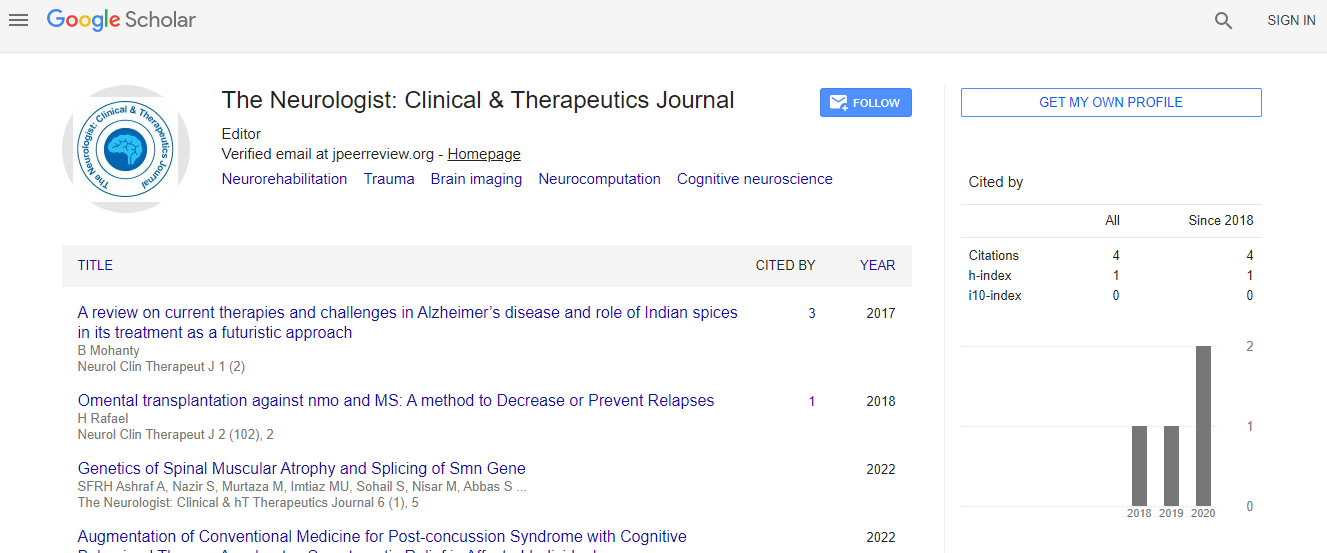Neurology Congress 2019 & Vascular Dementia Congress 2019: The role of bilateral repetitive transcranial magnetic stimulation in stroke patients - Ann Ali Abdelkader Hanafy - Cairo University
*Corresponding Author:
Copyright: © 2019 . This is an open-access article distributed under the terms of the Creative Commons Attribution License, which permits unrestricted use, distribution, and reproduction in any medium, provided the original author and source are credited.
Abstract
Repetitive transcranial magnetic stimulation is non-intrusive brain incitement to the engine cortex. It can change sensitivity of the mind after stroke by adjusting cortical action. At low frequencies (1 HZ or less), it has an inhibitory impact, while at high frequencies (5-25 HZ), it can upgrade cortical edginess. As it delivers durable impacts which persevere past the underlying time of incitement through long haul potentiating (LTP) and long-term depression(LTD) (Chen et al., 2008).
Following stroke, the brain experiences different phases of recuperation where the focal sensory system can revamp neural circuits (neuroplasticity) both spontaneously and with the aid of behavioral rehabilitation and non-invasive brain stimulation (Auriat, et al., 2015).
Motor deficits in patients after stroke are because of a reduced output from the influenced half of the globe and overabundance transcallosal hindrance of the influenced side of the equator from the unaffected side of the equator. In this manner, utilizing rTMS, could improve engine shortfalls by expanding the sensitivity of the influenced half of the globe or hindrance of the unaffected side of the equator thus the interhemispheric restraint, through expanding or diminishing the edginess of the neuronal circuits, which is called neuroplascity thus engine recuperation after stroke (Murase et al.,2004).
Cortical pliancy can be controlled to improve stroke result by various strategies, for example, task-situated physiotherapy. Assignment arranged exercise is expected to learn patients (contingent upon the possibility that learning is the premise of neuroplasticity) by permitting them to take a stab at taking care of issues effectively by furnishing them with a useful undertaking, rather than having them tediously practice the ordinary examples of developments. It is a methodology proposed to be an effective treatment technique, it comprises of undertakings that energize different practical exercises and help upgrade patient's capacity to perform day by day exercises and along these lines helping engine recuperation after stroke (Yoo and Park, 2015). For nonstop engine improvement, it is imperative to bestow extra engine preparing while dull trans cranial attractive incitement balances the neural system between the two halves of the globe and redesigns work in the influenced half of the globe (Takeuchi and izumi., 2012). Analysts have tried the adequacy of HF rTMS over the influenced side of the equator and viability of LF-rTMS over the unaffected side of the equator for patients post stroke (Khedr et al., 2009; Emara et al., 2010; Chang et al., 2010). Takeuchi et al., (2009) and Sung et al., (2013) speculated the wellbeing, achievability and viability of applying two-sided rTMS; HF-and LFrTMS in patients with interminable stroke.
In the current investigation we conjectured that the joined use of HF-rTMS over the influenced side of the equator and LF-rTMS over the unaffected side of the equator as reciprocal rTMS may encourage engine practical recuperation in patients with intense stroke. The current investigation was directed on various sorts; ischemic, hemorrhagic and embolic stroke, various destinations; supra and infratentorial stroke and related co-morbidities; ischemic coronary illness, vasculitis and atherosclerosis. Fifty-five patients with subacute stroke (fourteen days to a half year) were partitioned into four gatherings: two-sided, inhibitory, stimulatory and control gatherings. Reciprocal gathering got five meetings of high-recurrence 5Hz rTMS over the influenced half of the globe exchanging with low-recurrence 1 Hz rTMS over the unaffected side of the equator. Inhibitory gathering got low recurrence 1 Hz rTMS over the unaffected side of the equator rotated by trick 5 Hz rTMS over the influenced side of the equator.
Stimulatory bunch got high recurrence 5 Hz rTMS over the influenced side of the equator exchanged by hoax 1 Hz rTMS over the unaffected side of the equator. Control bunch got trick stimulatory rTMS over the influenced half of the globe substituted by hoax inhibitory rTMS over the unaffected. All meetings were related with task-situated physiotherapy from the very first moment of treatment till one month. Appraisal from before to after meetings then following one month was finished by FMA and WMFT to evaluate the engine execution, altered Ashworth scale for spasticity and MEP for cortical pliancy.
All gatherings demonstrated factually huge improvement of the engine incapacity of the paretic upper appendage post stroke evaluated by FMA, WMFT and change in edginess surveyed by MEP, from before to after meetings and following one month. At the point when gatherings were contrasted and one another, reciprocal gathering demonstrated the best improvement of spasticity estimated by the altered ashworth scale, while every single other gathering neglected to change the Ashworth scale. Control bunch neglected to show change in the MEP and stimulatory bunch neglected to change the MEP of the solid half of the globe and its impact was on the unfortunate side of the equator as it were.
Conclusion:
According to the finding yielded from this examination, it tends to be presumed that five day by day meetings of reciprocal rTMS joined with one month of errand situated physiotherapy, improves engine inability of the paretic upper appendage after stroke. Inhibitory and stimulatory rTMS show about same viability as respective convention, anyway reciprocal incitement is prevalent in spasticity. No relationship was found between progress in engine force and stroke term, site and degree of neurologic deficiency. Giving patients various sorts, locales of stroke and related comorbidities will help for future examining; it will open another pattern in rTMS examination and help upgrading the best rTMS module for every patient as indicated by type and site of stroke and related comorbidities.

 Spanish
Spanish  Chinese
Chinese  Russian
Russian  German
German  French
French  Japanese
Japanese  Portuguese
Portuguese  Hindi
Hindi 